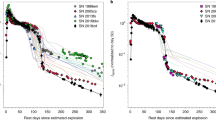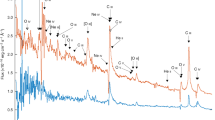Abstract
Type Ia supernovae have been used empirically as ‘standard candles’ to demonstrate the acceleration of the expansion of the Universe1,2,3 even though fundamental details, such as the nature of their progenitor systems and how the stars explode, remain a mystery4,5,6. There is consensus that a white dwarf star explodes after accreting matter in a binary system, but the secondary body could be anything from a main-sequence star to a red giant, or even another white dwarf. This uncertainty stems from the fact that no recent type Ia supernova has been discovered close enough to Earth to detect the stars before explosion. Here we report early observations of supernova SN 2011fe in the galaxy M101 at a distance7 from Earth of 6.4 megaparsecs. We find that the exploding star was probably a carbon–oxygen white dwarf, and from the lack of an early shock we conclude that the companion was probably a main-sequence star. Early spectroscopy shows high-velocity oxygen that slows rapidly, on a timescale of hours, and extensive mixing of newly synthesized intermediate-mass elements in the outermost layers of the supernova. A companion paper8 uses pre-explosion images to rule out luminous red giants and most helium stars as companions to the progenitor.
This is a preview of subscription content, access via your institution
Access options
Subscribe to this journal
Receive 51 print issues and online access
$199.00 per year
only $3.90 per issue
Buy this article
- Purchase on Springer Link
- Instant access to full article PDF
Prices may be subject to local taxes which are calculated during checkout




Similar content being viewed by others
References
Riess, A. G. et al. Observational evidence from supernovae for an accelerating universe and a cosmological constant. Astron. J. 116, 1009–1038 (1998)
Perlmutter, S. et al. Measurements of Ω and Λ from 42 high-redshift supernovae. Astrophys. J. 517, 565–586 (1999)
Sullivan, M. et al. SNLS3: constraints on dark energy combining the supernova legacy survey three-year data with other probes. Astrophys. J. 737, 102–121 (2011)
Howell, D. A. Type Ia supernovae as stellar endpoints and cosmological tools. Nature Commun. 2, 350 (2011)
Kasen, D., Röpke, F. K. & Woosley, S. E. The diversity of type Ia supernovae from broken symmetries. Nature 460, 869–872 (2009)
Yoon, S.-C., Podsiadlowski, P. & Rosswog, S. Remnant evolution after a carbon-oxygen white dwarf merger. Mon. Not. R. Astron. Soc. 380, 933–948 (2007)
Shappee, B. J. & Stanek, K. Z. A new Cepheid distance to the giant spiral M101 based on image subtraction of Hubble Space Telescope/Advanced Camera for Surveys observations. Astrophys. J. 733, 124–149 (2011)
Li, W. et al. Exclusion of a luminous red giant as a companion star to the progenitor of supernova SN 2011fe. Naturehttp://dx.doi.org/10.1038/nature10646 (this issue).
Nugent, P. E. et al. Young type Ia supernova PTF11kly in M101. Astron. Telegr. 3581, 1 (2011)
Thomas, R. C., Nugent, P. E. & Meza, J. C. SYNAPPS: data-driven analysis for supernova spectroscopy. Publ. Astron. Soc. Pacif. 123, 237–248 (2011)
Filippenko, A. V. Optical spectra of supernovae. Annu. Rev. Astron. Astrophys. 35, 309–355 (1997)
Branch, D. et al. The Type I supernova 1981b in NGC 4536 - the first 100 days. Astrophys. J. 270, 123–125 (1983)
Leibundgut, B. et al. Premaximum observations of the type IA SN 1990N. Astrophys. J. 371, L23–L26 (1991)
Nugent, P., Phillips, M., Baron, E., Branch, D. & Hauschildt, P. Evidence for a spectroscopic sequence among type 1a supernovae. Astrophys. J. 455, L147–L151 (1995)
Kirshner, R. P. et al. SN 1992A: ultraviolet and optical studies based on HST, IUE, and CTIO observations. Astrophys. J. 415, 589–615 (1993)
Patat, F. et al. The type IA supernova 1994D in NGC 4526: the early phases. Mon. Not. R. Astron. Soc. 278, 111–124 (1996)
Hatano, K., Branch, D., Fisher, A., Baron, E. & Filippenko, A. V. On the high-velocity ejecta of the type Ia supernova SN 1994D. Astrophys. J. 525, 881–885 (1999)
Piro, A. L., Chang, P. & Weinberg, N. N. Shock breakout from type Ia supernova. Astrophys. J. 708, 598–604 (2010)
Kasen, D. Seeing the collision of a supernova with its companion star. Astrophys. J. 708, 1025–1031 (2010)
Fryer, C. L. et al. Spectra of type Ia supernovae from double degenerate mergers. Astrophys. J. 725, 296–308 (2010)
Shen, K. J., Bildsten, L., Kasen, D. & Quataert, E. The long-term evolution of double white dwarf mergers. Preprint at 〈http://arxiv.org/abs/1108.4036〉 (2011)
Rau, A. et al. Exploring the optical transient sky with the Palomar Transient Factory. Publ. Astron. Soc. Pacif. 121, 1334–1351 (2009)
Law, N. M. et al. The Palomar Transient Factory: system overview, performance, and first results. Publ. Astron. Soc. Pacif. 121, 1395–1408 (2009)
Gal-Yam, A. et al. Real-time detection and rapid multiwavelength follow-up observations of a highly subluminous type II-P supernova from the Palomar Transient Factory survey. Astrophys. J. 736, 159–166 (2011)
Bloom, J. S. et al. Automating discovery and classification of transients and variable stars in the synoptic survey era. Preprint at 〈http://arxiv.org/abs/1106.5491〉 (2011)
de Vaucouleurs, G. et al. Third Reference Catalogue of Bright Galaxies (Springer, 1991)
Rabinak, I., Livne, E. & Waxman, E. Early emission from type Ia supernovae. Preprint at 〈http://arxiv.org/abs/1108.5548〉 (2011)
Acknowledgements
The PTF project is a scientific collaboration between the California Institute of Technology, Columbia University, Las Cumbres Observatory, the Lawrence Berkeley National Laboratory, the National Energy Research Scientific Computing Center, the University of Oxford and the Weizmann Institute of Science. The National Energy Research Scientific Computing Center, supported by the Office of Science of the US Department of Energy (DOE), provided staff, computational resources and data storage for this project. P.E.N. acknowledges support from the US DOE Scientific Discovery through Advanced Computing programme. M.S. acknowledges support from the Royal Society. J.S.B. and L.B. were supported by the National Science Foundation (NSF). The work of A.V.F. is funded by the NSF, the TABASGO Foundation, Gary and Cynthia Bengier, and the Richard and Rhoda Goldman Fund. A.G. thanks the ISF and BSF. The Liverpool Telescope is operated by Liverpool John Moores University in the Spanish Observatorio del Roque de los Muchachos of the Instituto de Astrofisica de Canarias with financial support from the UK Science and Technology Facilities Council. Some of the data presented here were obtained at the W. M. Keck Observatory, which is operated as a scientific partnership among the California Institute of Technology, the University of California and NASA; the observatory was made possible by the generous financial support of the W. M. Keck Foundation. We thank the staffs of the many observatories at which data were obtained for their assistance.
Author information
Authors and Affiliations
Contributions
P.E.N., M.S. and D.A.H. oversee the PTF programme on type Ia supernovae. P.E.N. oversaw the preparation of the manuscript. M.S., D.B., K.M., Y.-C.P., J.L. and P.J. performed and reduced the FRODOSpec observations. S.B.C., M.T.K., A.V.F. and J.M.S. obtained and reduced the Lick spectrum. G.W.M., A.W.H. and H.T.I. obtained the HIRES observations. S.B.C., J.S.B., S.R.K., M.M.K., N.M.L., E.O.O., R.M.Q. and D.P. assisted in the operation of the Palomar 48-inch telescope as part of the PTF collaboration. R.C.T. and J.E.T. performed the SYNAPPS analysis. D.K., L.B. and P.P. assisted with the theoretical interpretation of our observations. N.S., B.J.F., J.T.P., D.S., F.B.B., B.D., M.L.G., I.M.H., P.M., E.P., E.S.W. and A.G. assisted in follow-up observations of SN 2011fe.
Corresponding author
Ethics declarations
Competing interests
The authors declare no competing financial interests.
Supplementary information
Supplementary Information
The file contains Supplementary Text and Data, Supplementary Table 1, Supplementary Figure 1 with a legend and additional references. (PDF 213 kb)
Rights and permissions
About this article
Cite this article
Nugent, P., Sullivan, M., Cenko, S. et al. Supernova SN 2011fe from an exploding carbon–oxygen white dwarf star. Nature 480, 344–347 (2011). https://doi.org/10.1038/nature10644
Received:
Accepted:
Published:
Issue Date:
DOI: https://doi.org/10.1038/nature10644
This article is cited by
-
Science with the 2.5-meter Wide Field Survey Telescope (WFST)
Science China Physics, Mechanics & Astronomy (2023)
-
Infant-phase reddening by surface Fe-peak elements in a normal type Ia supernova
Nature Astronomy (2022)
-
Observational properties of thermonuclear supernovae
Nature Astronomy (2019)
-
Type Ia Supernova Cosmology
Space Science Reviews (2018)
-
Peculiar Supernovae
Space Science Reviews (2018)
Comments
By submitting a comment you agree to abide by our Terms and Community Guidelines. If you find something abusive or that does not comply with our terms or guidelines please flag it as inappropriate.



